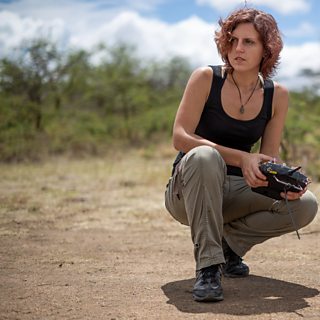Should we have built a waterhole?
Is adding artificial water a solution or a problem? It all depends on context.
By Waterhole scientific advisor, Dr. Meredith S. Palmer

At the height of the dry season in the African savannah, the blistering midday sun beats down from overhead. Slowly, the earth dries out as the streams and puddles that previously covered the landscape evaporate into thin air. If you’re an animal living in this environment, you quickly start to dehydrate and overheat in these unforgiving temperatures. What do you require above all else to survive? Water.

It all boils down to how surprisingly powerful waterholes are in changing the face of entire ecosystems.
Across Africa, wildlife’s need for this indispensable resource impacts their lives. The semi-arid savannahs follow a boom and bust cycle, dramatically shifting between periods of water abundance and water scarcity. Surface water is unevenly distributed; it can be plentiful in some locations while markedly absent in others.
The amount of accessible water present in a landscape is a powerful force shaping the structure and functioning of the entire ecosystem. As rains cease and daily temperatures start to rise, animals flock from all over to congregate at the few vital sources of permanent water left in the landscape. As the dry season progresses, waterholes increasingly become dynamic communities of competition, predation, and social interaction.
In natural systems, animals go to extreme measures to obtain water, such as migrating hundreds of miles to follow seasonal rains. However, sufficient access to water is harder and harder to come by in our rapidly changing world. Global warming makes savannah ecosystems more strongly seasonal, affecting the timing and intensity of life-giving rains and making the already harsh dry seasons even more brutal.
Wild areas are also increasingly coming under the intensive management of humans. For better or for worse, animals are losing their ability to move around their environments to follow the ever-changing spatial patterns of water, exacerbating the consequences of dramatic shifts in resource availability. Under these circumstances, adding artificial water points is becoming a common, if controversial, wildlife management strategy. But how could adding more of a necessary resource be contentious? It all boils down to how surprisingly powerful waterholes are in changing the face of entire ecosystems.
Adding artificial waterholes has a long history in southern Africa, where water was commonly supplemented to manage animal densities year-round and provide wildlife viewing opportunities for tourists. Many animals need to access water at least once a day, so water points were deployed across wildlife reserves in systematic networks that enabled such species to access as much of the landscape as possible.

The scientific community is continuously examining different ways to use artificial waterholes as a tool for conservation
Unfortunately, creating these constant supplies of what was previously a limited resource affected animal densities, distributions, and connections. It’s a tactic that could catastrophically backfire and end up causing significant harm to vulnerable wildlife populations and degrading the very habitats that the waterholes were put in to support. Which is why planning and extensive knowledge of the habitat you’re adding new water sources to are the key to its success as a conservation strategy.
Nearly a year and a half of planning was undertaken by Mwiba Wildlife reserve when they decided they wanted to provide wildlife with an additional water source; they worked with local communities, scientists and the Tanzanian Government before deciding on the location of this new waterhole: in an area that is water stressed but that still has lots of other nearby water sources so that the impact to animal behaviour and the habitat would be minimised.
The intentions for building a waterhole at Mwiba also highlights another significant challenge facing Africa’s wildlife: conflict with humans. The reserve boundaries are home to many communities, many of which herd cattle – adding further stress on local natural resources like water. Indeed, we may be ethically responsible for providing water when the possibility exists to reduce human-wildlife conflict, where we must sustain wildlife populations that are prohibited from accessing historic water sources, or when our actions have removed water that originally supported life in these areas. Wild and domesticated herbivores often vie for water in these parched landscapes, and the addition of boreholes and dams inside protected areas, like the new waterhole on Mwiba, can reduce competition and disease-transmitting contact between these species while encouraging wildlife to remain inside reserves and away from poachers and people.
When it comes to providing for animals who can no longer obtain water due to human actions, Ruaha National Park in Tanzania is a prime example. In this Tanzania savannah system, mismanagement upstream of the protected area caused the formerly perennial Great Ruaha River to cease flowing during the dry season. Artificial waterholes placed within the reserve protected wildlife populations by alleviating the effects of this human caused water shortage.
Like in Ruaha, the waterhole in Mwiba Wildlife Reserve is a long-term project, a permanent water source and as such its effects need to be studied long term. The scientific community is continuously examining different ways to use artificial waterholes as a tool for conservation and cannot stress strongly enough the importance of scientific research in understanding the role waterholes play in life on the African savannah.
